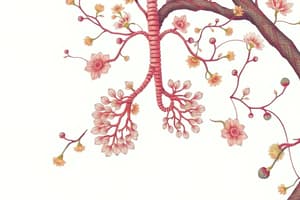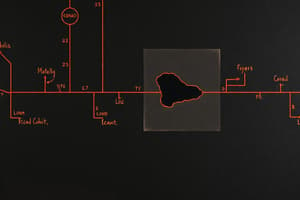Podcast
Questions and Answers
What is a defining characteristic of metabolic pathways?
What is a defining characteristic of metabolic pathways?
- They occur only in the mitochondria.
- They are linear and do not interact.
- They do not require any energy input.
- Each step is catalyzed by a specific enzyme. (correct)
Which of the following is an example of a catabolic pathway?
Which of the following is an example of a catabolic pathway?
- Citric Acid Cycle
- Protein synthesis
- Photosynthesis
- Glycolysis (correct)
What role do enzymes play in metabolic pathways?
What role do enzymes play in metabolic pathways?
- They provide energy for reactions.
- They speed up chemical reactions. (correct)
- They slow down metabolic reactions.
- They are substrates in the reactions.
Which process is part of oxidative phosphorylation?
Which process is part of oxidative phosphorylation?
What is metabolic flux?
What is metabolic flux?
Which of the following processes occurs in the cytoplasm?
Which of the following processes occurs in the cytoplasm?
What can lead to metabolic disorders?
What can lead to metabolic disorders?
What is the primary function of anabolic pathways?
What is the primary function of anabolic pathways?
Flashcards are hidden until you start studying
Study Notes
Definition
- A metabolic pathway is a series of chemical reactions occurring within a cell.
- Each step is catalyzed by a specific enzyme.
Types of Metabolic Pathways
-
Catabolic Pathways
- Break down molecules to release energy.
- Example: Glycolysis (breakdown of glucose).
-
Anabolic Pathways
- Build larger molecules from smaller units, requiring energy.
- Example: Protein synthesis from amino acids.
Characteristics
- Interconnectedness: Pathways are interconnected and can share intermediates.
- Regulation: Enzymes in pathways are regulated by factors such as substrate availability and feedback mechanisms.
- Energetics: Pathways often involve energy transfers (ATP, NADH, FADH2).
Key Concepts
- Substrates and Products: Each pathway has specific substrates (reactants) and products (end products).
- Enzymes: Proteins that speed up reactions; highly specific to their substrates.
- Metabolic Flux: The rate at which substrates and products flow through a pathway.
Examples of Important Metabolic Pathways
-
Glycolysis
- Converts glucose into pyruvate.
- Occurs in the cytoplasm; produces ATP and NADH.
-
Citric Acid Cycle (Krebs Cycle)
- Occurs in mitochondria; processes acetyl-CoA to produce NADH, FADH2, and ATP.
-
Oxidative Phosphorylation
- Takes place in mitochondrial inner membrane; uses NADH and FADH2 to produce ATP via the electron transport chain.
-
Photosynthesis
- Converts light energy into chemical energy; involves light reactions and the Calvin cycle.
Importance
- Metabolic pathways are crucial for:
- Energy production.
- Synthesis of biomolecules.
- Regulation of metabolic balance in the cell.
Disorders Related to Metabolic Pathways
- Metabolic disorders can arise from enzyme deficiencies, leading to accumulation of toxic metabolites or lack of essential products (e.g., phenylketonuria, diabetes).
Tools for Study
- Metabolic Maps: Visual representations of pathways.
- Enzyme Kinetics: Study of how enzymes catalyze reactions.
- Metabolomics: Analysis of metabolites to understand metabolic processes.
Definition
- Metabolic pathways consist of a series of interconnected chemical reactions within a cell.
- Each reaction within a pathway is catalyzed by a specific enzyme, facilitating metabolism.
Types of Metabolic Pathways
-
Catabolic Pathways:
- Function to break down larger molecules, releasing energy in the process.
- Glycolysis exemplifies catabolic pathways by metabolizing glucose into pyruvate.
-
Anabolic Pathways:
- Operate to construct larger molecules from smaller units, a process that consumes energy.
- Protein synthesis utilizes amino acids to form proteins, showcasing anabolic pathways.
Characteristics
-
Interconnectedness:
- Metabolic pathways often share intermediates, allowing for integration and coordination.
-
Regulation:
- Enzyme activity is regulated by factors like substrate availability, product concentration, and feedback inhibition mechanisms.
-
Energetics:
- Energy transfers play a critical role in metabolic pathways, commonly involving molecules like ATP, NADH, and FADH2.
Key Concepts
-
Substrates and Products:
- Each pathway is defined by specific reactants (substrates) and end products, facilitating unique biochemical transformations.
-
Enzymes:
- Proteins that accelerate metabolic reactions; they exhibit high specificity for their respective substrates.
-
Metabolic Flux:
- Refers to the speed at which substrates are converted to products within a metabolic pathway, influencing overall cellular function.
Examples of Important Metabolic Pathways
-
Glycolysis:
- Converts glucose into pyruvate, occurring in the cytoplasm with a net production of ATP and NADH.
-
Citric Acid Cycle (Krebs Cycle):
- Takes place in the mitochondria, processing acetyl-CoA to generate NADH, FADH2, and ATP.
-
Oxidative Phosphorylation:
- Occurs in the inner mitochondrial membrane, where NADH and FADH2 facilitate ATP production through the electron transport chain.
-
Photosynthesis:
- Transforms light energy into chemical energy through light-dependent reactions and the Calvin cycle.
Importance
- Metabolic pathways are essential for:
- Energy production to fuel cellular activities.
- Synthesis of vital biomolecules, maintaining cellular structure and function.
- Regulation of metabolic balance, ensuring homeostasis within cells.
Disorders Related to Metabolic Pathways
- Metabolic disorders, such as phenylketonuria and diabetes, may occur due to enzyme deficiencies, resulting in the accumulation of harmful metabolites or a deficit of critical products.
Tools for Study
-
Metabolic Maps:
- Serve as visual aids to illustrate the relationships and flow within metabolic pathways.
-
Enzyme Kinetics:
- Involves examining enzyme activity and efficiency in catalyzing reactions, providing insights into metabolic regulation.
-
Metabolomics:
- The study of metabolites provides a detailed understanding of metabolic processes and disruptions.
Studying That Suits You
Use AI to generate personalized quizzes and flashcards to suit your learning preferences.




